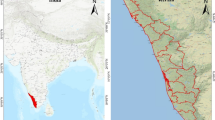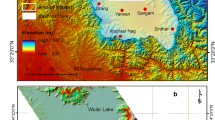Abstract
In recent years, the significant increase in research on spatial information is observed. Classification or clustering is one of the well-known methods in spatial data analysis. Traditionally, classifiers are generally based on per-pixel approaches and are not utilizing the spatial information within pixel, called mixels which is an important source of information to image classification. There are two foremost reasons behind the existence of mixels: (a) coarse or low spatial resolution of sensor and (b) topographic effects that recorded on optical satellite imagery due to differential terrain illuminations over rugged areas such as Himalayas. In the present study, different classification algorithms have been implemented to drive the impact of topography on them. Among various available, three algorithms for the mapping of snow cover region over north Indian Himalayas (India) are compared: (a) maximum likelihood classification (MLC) as supervised classifier; (b) k-mean clustering as unsupervised classifier; and (c) linear spectral mixing model (LSMM) as soft classifier. These algorithms have been implemented on AWiFS multispectral data, and analysis was carried out. The classification accuracy is estimated by the error matrices, and LSMM achieved higher accuracy (84.5–88.5%) as compared to MLC (81–84%) and k-mean (74–81%). The results highlight that topographically derived classifiers achieved better accuracy in mapping as compared to simple classifiers. The study has many applications in snow hydrology, glaciology and climatology of mountain topography.






Similar content being viewed by others
References
Besheer, M., & Abdelhafiz, A. (2015). Modified invariant colour model for shadow detection. International Journal of Remote Sensing, 36(24), 6214–6223. https://doi.org/10.1080/01431161.2015.1112930.
Celik, T. (2009). Unsupervised change detection in satellite images using principal component analysis and k-means clustering. IEEE Geoscience and Remote Sensing Letters, 6(4), 772–776. https://doi.org/10.1109/LGRS.2009.2025059.
Colby, J. D. (1991). Topographic normalization in rugged terrain. Photogrammetry Engineering Remote Sensing, 57(5), 531–537.
Congalton, R. G. (1991). A review of assessing the accuracy of classifications of remotely sensed data. Remote Sensing of Environment, 37(1), 35–46. https://doi.org/10.1016/0034-4257(91)90048-b.
Dare, P. M. (2005). Shadow analysis in high-resolution satellite imagery of urban areas. Photogrammetric Engineering & Remote Sensing, 71(2), 169–177.
Dean, A. M., & Smith, G. M. (2003). An evaluation of per-parcel land cover mapping using maximum likelihood class probabilities. International Journal of Remote Sensing, 24(14), 2905–2920. https://doi.org/10.1080/01431160210155910.
Foody, G. M., & Atkinson, P. M. (Eds.). (2003). Uncertainty in remote sensing and GIS. London: Wiley. https://doi.org/10.1002/0470035269.
Gao, M. L., Zhao, W. J., Gong, Z. N., Gong, H. L., Chen, Z., & Tang, X. M. (2014). Topographic correction of ZY-3 satellite images and its effects on estimation of shrub leaf biomass in mountainous areas. Remote Sensing, 6(4), 2745–2764. https://doi.org/10.3390/rs6042745.
HongLei, Y., JunHuan, P., BaiRu, X., & DingXuan, Z. (2013). Remote sensing classification using fuzzy C-means clustering with spatial constraints based on Markov random field. European Journal of Remote Sensing, 46(1), 305–316. https://doi.org/10.5721/eujrs20134617.
Hudson, W. D., & Ramm, C. W. (1987). Correct formulation of the kappa coefficient of agreement. Photogrammetric Engineering and Remote Sensing, 53(4), 421–422.
Lillesand, T., Kiefer, R. W., & Chipman, J. (2015). Remote sensing and image interpretation (7th ed.). London: Wiley.
Ling, F., Du, Y., Xiao, F., & Li, X. (2012). Subpixel land cover mapping by integrating spectral and spatial information of remotely sensed imagery. IEEE Geoscience and Remote Sensing Letters, 9(3), 408–412. https://doi.org/10.1109/Lgrs.2011.2169934.
Lu, D., & Weng, Q. (2007). A survey of image classification methods and techniques for improving classification performance. International Journal of Remote Sensing, 28(5), 823–870. https://doi.org/10.1080/01431160600746456.
Memarsadeghi, N., Mount, D. M., Netanyahu, N. S., & Le Moigne, J. (2007). A fast implementation of the ISODATA clustering algorithm. International Journal of Computational Geometry & Applications, 17(01), 71–103. https://doi.org/10.1142/s0218195907002252.
Mishra, V. D., Negi, H. S., Rawat, A. K., Chaturvedi, A., & Singh, R. P. (2009a). Retrieval of sub-pixel snow cover information in the Himalayan region using medium and coarse resolution remote sensing data. International Journal of Remote Sensing, 30(18), 4707–4731. https://doi.org/10.1080/01431160802651959.
Mishra, V. D., Sharma, J. K., Singh, K. K., Thakur, N. K., & Kumar, M. (2009b). Assessment of different topographic corrections in AWiFS satellite imagery of Himalaya terrain. Journal of Earth System Science, 118(1), 11–26. https://doi.org/10.1007/s12040-009-0002-0.
Nichol, J., Hang, L. K., & Sing, W. M. (2006). Empirical correction of low sun angle images in steeply sloping terrain: A slope matching technique. International Journal of Remote Sensing, 27(3), 629–635. https://doi.org/10.1080/02781070500293414.
Nyborg, L., & Sandholt, I. (2001). NOAA-AVHRR based flood monitoring. In IEEE 2001 international geoscience and remote sensing symposium, 2001. IGARSS’01 (Vol. 4, pp. 1696–1698). https://doi.org/10.1109/igarss.2001.977041.
Otukei, J. R., & Blaschke, T. (2010). Land cover change assessment using decision trees, support vector machines and maximum likelihood classification algorithms. International Journal of Applied Earth Observation and Geoinformation, 12, S27–S31. https://doi.org/10.1016/j.jag.2009.11.002.
Sharma, V., Mishra, V. D., & Joshi, P. K. (2014). Topographic controls on spatio-temporal snow cover distribution in Northwest Himalaya. International Journal of Remote Sensing, 35(9), 3036–3056. https://doi.org/10.1080/01431161.2014.894665.
Sharma, J. K., Mishra, V. D., & Khanna, R. (2013). Impact of topography on accuracy of land cover spectral change vector analysis using AWiFS in Western Himalaya. Journal of the Indian Society of Remote Sensing, 41(2), 223–235. https://doi.org/10.1007/s12524-011-0180-5.
Simhachalam, B., & Ganesan, G. (2015). Performance comparison of fuzzy and non-fuzzy classification methods. Egyptian Informatics Journal, 17(2), 183–188. https://doi.org/10.1016/j.eij.2015.10.004.
Singh, S., Sharma, J. K., & Mishra, V. D. (2011). Topographic influence on improved change vector analysis using MODIS satellite data of western Himalaya. International Journal of Advanced Engineering Sciences and Technologies, 7(1), 77–84.
Singh, S., & Talwar, R. (2017). Response of fuzzy clustering on different threshold determination algorithms in spectral change vector analysis over Western Himalaya, India. Journal of Mountain Science, 14(7), 1391–1404. https://doi.org/10.1007/s11629-016-4248-0.
Singh, S., & Talwar, R. (2018). An intercomparison of different topography effects on discrimination performance of fuzzy change vector analysis algorithm. Meteorology and Atmospheric Physics, 130(1), 125–136. https://doi.org/10.1007/s00703-016-0494-5.
Sood, V., & Singh, S. (2018). Analytical analysis of different shadow removing algorithms over land-use 1 and land-cover classification. Himalayan Geology, 39(2), 223–232.
Wang, Z., Wei, W., Zhao, S., & Chen, X. (2004). Object-oriented classification and application in land use classification using SPOT-5 PAN imagery. In Geoscience and remote sensing symposium, 2004. IGARSS’04 (Vol. 5, pp. 3158–3160). https://doi.org/10.1109/igarss.2004.1370370.
Wu, K., Zhong, Y., Wang, X., & Sun, W. (2017). A novel approach to subpixel land-cover change detection based on a supervised back-propagation neural network for remotely sensed images with different resolutions. IEEE Geoscience and Remote Sensing Letters, 14(10), 1750–1754. https://doi.org/10.1109/LGRS.2017.2733558.
Acknowledgements
The authors would like to thank Indian Remote Sensing (IRS) for their great efforts in developing and distributing remotely sensed AWiFS satellite data and their DEM products online to public for free downloading. Thanks are also due to United States Geological Survey (USGS) for providing ASTER Global DEM and Landsat 8 data for research and educational purposes.
Author information
Authors and Affiliations
Corresponding author
Ethics declarations
Conflict of interest
No potential conflict of interest was reported by the authors.
About this article
Cite this article
Sood, V., Gupta, S., Gusain, H.S. et al. Spatial and Quantitative Comparison of Topographically Derived Different Classification Algorithms Using AWiFS Data over Himalayas, India. J Indian Soc Remote Sens 46, 1991–2002 (2018). https://doi.org/10.1007/s12524-018-0861-4
Received:
Accepted:
Published:
Issue Date:
DOI: https://doi.org/10.1007/s12524-018-0861-4




